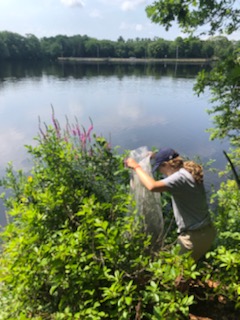The invasive plant purple loosestrife (Lythrum salicaria) can be found across the northern United States in wetland areas. This plant, which was introduced from Europe, has been encroaching on Jacobs Pond in Norwell, a propery under the stewardship of the Norwell Conservation Commission, which is the headwater to the Third Herring Brook, and is limiting recreational access to a cove in the pond. Purple loosestrife can outcompete native plants and limit the biodiversity in these wetland ecosystems.
The Norwell Conservation Commission, spearheaded by members Bob Woodill and Patricia DeGiulio, with funding from the Norwell Community Preservation Committee, partnered with the NSRWA to take a natural biological approach to control this invasive growth by breeding the Galerucella beetle, which has a diet of only purple loosestrife. The NSRWA has undertaken a similar approach before at the former Mill Pond Dam site in Hanover on the Third Herring Brook with great success. The poor quality and reduction of the purple loosestrife in that area indicates that the Galerucella beetle has been successful in controlling the abundance there.
 This June, we collected a number of beetles, eggs, and larvae from Mill Pond to start a colony of beetles that could be released at Jacobs Pond to manage purple loosestrife. For the past month and a half we have been caring for the beetles at the NSRWA office. We released the beetles at Jacobs Pond this Thursday morning, and watched them take off into their new habitat. We will continue to monitor the presence of the Galerucella beetles as well as the health of the purple loosestrife at Jacobs Pond in hopes that the beetles control this invasive species as they have at Mill Pond.
This June, we collected a number of beetles, eggs, and larvae from Mill Pond to start a colony of beetles that could be released at Jacobs Pond to manage purple loosestrife. For the past month and a half we have been caring for the beetles at the NSRWA office. We released the beetles at Jacobs Pond this Thursday morning, and watched them take off into their new habitat. We will continue to monitor the presence of the Galerucella beetles as well as the health of the purple loosestrife at Jacobs Pond in hopes that the beetles control this invasive species as they have at Mill Pond.



